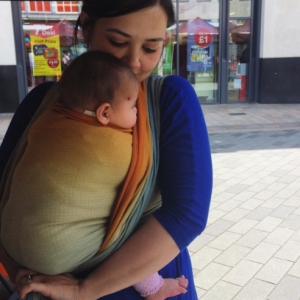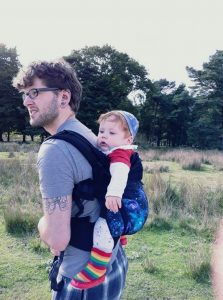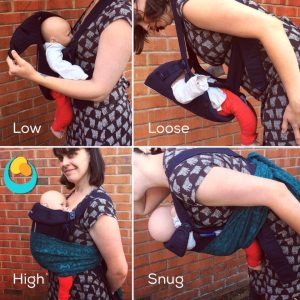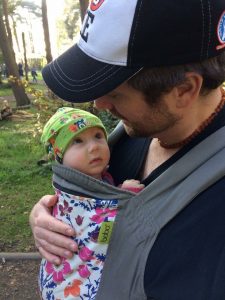Are baby slings and carriers worth it? From time to time websites publish articles that suggest that baby carriers can be an expensive waste of money, or featuring them in the "top ten most useless items."Is there any truth in these claims? The best people to ask will of course be those who work with slings and carriers daily and know how to use them, and a wide cross section of families! One person's experience is not enough to make an informed decision, so take such "lists" with a pinch of salt.
Let me begin by saying first of all, that carrying babies is important; our babies need to be held close to us so their brains and bodies can grow optimally and thrive. Loving nurture and connectedness in the early months and years predicts a more positive future for a child. Holding and carrying babies is free, all you need is your arms! However, few of us manage to hold babies for any length of time as our bodies are often not as strong as they used to be, and few of us have the luxury of being able to take the time to just cuddle babies. This is where baby slings and carriers can be so useful, providing nurture while life goes on.
Magazines and articles who suggest that baby carriers are an expensive waste of money usually cite reasons such as
1) babies cry in slings so parents don’t use them, wasting their money
2) they are only used a handful of times as they can make babies clingy, so they are a waste of money
3) babies grow out of the carriers in a short space of time, so they are a waste of money
4) they are difficult to use and uncomfortable, so are not worth spending money on
5) they are a new fad or a marketing gimmick, so don’t waste your money!
You get the idea! All these reasons are easy to refute, and issues are often simple and easy to fix, when you know how. There is a wealth of guidance and support out there; both online (such as the Carrying Matters Guide to Slings or social media groups) and in person at sling libraries.
Let’s look at number 1 first.
“Babies cry in slings so parents don’t use them, wasting their money.”
This is a common problem. “Slings are great for sleeping, all the photos on the internet show peaceful babies snoozing away, don’t they?” So a tired and anxious parent with an irritable baby tries the carrier. As soon as they put the baby in, the baby cries, so they take the baby straight out again, and everyone is that little bit more irritable and harder to calm down. Or they may put baby into the carrier, and it seems to have lots of bits and clips that are hard to navigate and do up, and as they struggle, baby loses patience and begins to cry, so they take the baby out.
Perhaps the carrier isn’t the right size for the baby so baby feels too enclosed and cannot see, or has fabric in front of the face, and begins to cry. Perhaps baby is hot and being placed in a carrier makes them feel warmer, or the carrier isn’t comfortable.
More often than not, babies cry for many other reasons, such as being overtired (and being put into the carrier is one stimulation too far). They may be hungry or thirsty and upset that they aren’t being fed. They may be aware of their bowel needing to move, or need a change of nappy. They may have that mysterious thing called “colic”.
It’s easy to see why people may believe that their babies hate slings… when in fact there are usually a lot of things that can help make it work happily for everyone.
Babies cry in arms and in car seats and in cradles and in buggies; after all. It may just take a little getting used to, for you both, a little practice without the baby, reading the instructions or videos before you try the carrier. Carriers may look complicated, but there are many very simple ones around; it will be worth doing a little research and trying things out at your local library.
The majority of babies love their carriers, when they are comfy and parents are confident. A little guidance from someone with sling training at a sling library or someone with a lot of real-life experience will be enormously helpful.
Read this “help, my child cries in the sling” article for more guidance.
Point number 2
“They are only used a handful of times as they can make children clingy, so they are a waste of money.”

Babies need to be held and carried, often, every day.
The statistics about how little time many of us spend in close contact with our vulnerable little people is disturbing; one small study in the UK in 2000 showed that by the age of six weeks, a parent was spending only 61 minutes holding their crying or sleeping infant, and by one year this had declined to 17 minutes a day. (1)
Babies’ bodies are perfectly developed to spend their first few months close to their parents; the parent’s body is the normal biological habitat for a pre-walking child. We as a culture put our babies down too quickly, rather than giving them the close nurturing contact their bodies and brains need to develop optimally and thrive. We know that the more connected a baby feels to their primary caregivers, the more secure they feel in their relationships, and the more confident they become to explore the world, as they have a reliable foundation to rely on.
If your baby feels heavy in your arms, keep on carrying, your muscles will tone and strengthen alongside theirs. They will learn to grip onto you and become easier to carry. If you need your hands back or your arms feel too tired, use a comfy carrier to help keep your baby close.
It will not make them clingy (read more here); it will help them develop a secure attachment to you and become a more confident child.
Number 3
Babies grow out of the carriers in a short space of time, so they are a waste of money

It has helped to soothe your baby, helped them to sleep contentedly in their favourite place, helped them learn to be loved and helped them build trust in this particularly vulnerable stage while you have your hands free, this makes it worth every penny.
Many parents then move on to an alternative for an older baby (in the same way they would do with a car seat), grateful to the sling for all it has given them. Many pass it on to their friends to appreciate and enjoy with their own babies!
Many baby carriers (usually ones made by specialists in this area) have been designed to grow with the baby into toddlerhood, rather than lasting only a few weeks. Most well-designed brands will be able to back carry older babies safely and comfortably, making them longer lasting and more useful. It is worth doing some research; such carriers are often more expensive than supermarket or online options, as you would expect, due to the time spent on their design, as well as their comfort, sturdiness and longevity.
If you are on a budget, there are ways to find carriers that will be comfy and last a while.
Look for good quality carriers second-hand, ask your local sling libraries if they can recommend any brands to look out for, or any good selling groups. Many of your friends may have carriers they would love to pass on to you. They may say “it never worked for me” as they pass it on.. but don’t be discouraged, seek sling support so that it can work for you!
Some areas have special schemes to help families in hardship. Some shops may do payment plans or layaways.
An investment in a comfortable sling that will last into toddlerhood may feel like a big outlay, but may end up less expensive than buying three or four cheaper carriers that never feel right and aren’t used at all.
A comfy carrier that you love and use daily may well become one of the most important tools in your parenting journey, and worth every penny.
Point 4
They are difficult to use and uncomfortable, so are not worth spending money on.
It is true that some baby slings and carriers look very complicated. They may feel overwhelming in the early weeks when parents are tired and it is harder to retain new information. Even with good instructions, many people find they learn better with someone else’s support, so do find your local sling library who can help you make sense of it. There are also many very simple options available; a bit of preparation and research will help, as well as going to a sling library for ideas and practice before you buy anything. Renting one for a week or two to check it works and feels good will avoid the need to buy several that aren’t comfortable.
Some cheaper carriers that are sold by supermarkets or on online giants like eBay or Amazon are often poor copies of those that are have been designed with care and thought.
They may have “weight limits” to 15kg but parents often find them uncomfortable long before this, due to the less-than-ideal design that doesn’t distribute weight well and baby can feel as if they are “hanging off the shoulders” and very heavy. A £13 carrier (the price of one high street buckle carrier), will have £13 worth of thoughtful design and investment in comfort.
Sometimes, parents wonder about using a baby carrier to keep their children close, which is fantastic; a brilliant thing to consider. They may not be aware of sling library resources, and may opt to try out a cheaper carrier “to see if I like it”… to help them decide if it is worth investing in a more expensive one later.
Unfortunately, as these cheaper carriers don’t focus as much on baby safety or comfort, or parent comfort and ease of use, they’re not the greatest introduction to the world of happy and joyful babywearing. Baby may not enjoy it, parent may find it uncomfortable, so this brings an early end to the carrying journey.
There are ways to make a carrier that feels low, loose and uncomfortable feel a lot safer and far more comfy. When baby is in the carrier, lift them into the “close enough to kiss” position and see if there are any straps that can be tightened to keep baby in that position when you take your hands off. Using a scarf at the base of the carrier to raise baby and bring them closer will often help too. Your local sling library can help you make the most of your current carrier.
I meet parents who have spent a lot of time researching and choosing a pram and buying the best pram their budget can stretch to. It is worth putting the same level of preparation into a sling, and seeking support from people who can help you ensure your investment really works well. After all, the carrier needs to fit the baby and fit the parent, and comfort is worth it. It is so helpful trying things out first and getting support and troubleshooting for any problems.
Number 5
5) they are a new fad or a marketing gimmick, so don’t waste your money!

Babies are evolved to spend their first few months being carried on their mothers’ bodies, being fed on demand and kept close and safe. It is normal human behaviour, and in fact the current trend for increasing separation between parent and child is the anomaly in the human story.
Our bodies and brains have not evolved as fast as technology; to ignore our biology and physiology brings ill health. Babies who are in close contact with their parents have healthier brains, are able to learn conversational and social skills, and when baby wants to have a different viewpoint, back carries are the way forwards! A new baby can be kept close while a toddler is played with.. a child can be carried easily on public transport or exploring the outdoors when little legs get tired. Unwell or disabled children can take more part in family life, so many good things can happen with a comfortable well fitting sling.
You can read more about why carrying matters here; the huge benefits for babies, for parents and for our whole society.
 The benefits of close contact are enormous. The investment you are making in your child’s future by keeping them close is priceless.
The benefits of close contact are enormous. The investment you are making in your child’s future by keeping them close is priceless.
Choose a well designed sling, as it can make so much of life more possible. The extra outlay will be worth it if you also invest the time in getting to know it; ask an experienced friend who has tried several, seek information from good, independent online guides and most importantly, visit a sling library if you can.
Being able to try a carrier to see how well it fits your baby and you together as a pairing and learning how to use it comfortably before you buy your own is enormously valuable.
With the right support, buying a carrier may become the best investment you ever made.
______________
Ref
-
Baildam, E. M., Hillier, V. F., Menon, S. , Bannister, R. P., Bamford, F. N., Moore, W. M. and Ward, B. S. (2000), Attention to infants in the first year. Child: Care, Health and Development, 26: 199-216.







 The benefits of close contact are enormous. The investment you are making in your child’s future by keeping them close is priceless.
The benefits of close contact are enormous. The investment you are making in your child’s future by keeping them close is priceless.